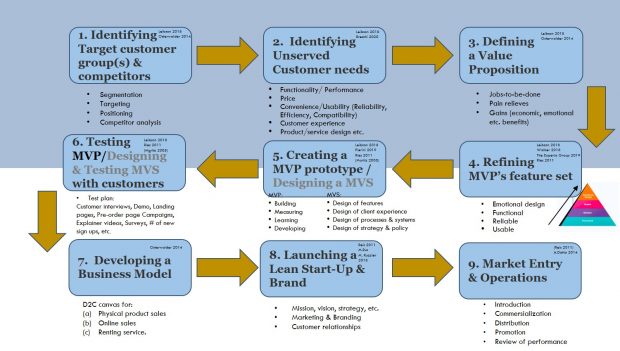There are myriads of new interesting, innovative ideas how to help patience with various problems. However, much fewer ideas find their way to the market and become real innovations. Knowing that I am a Master´s student in business, a startup company has turned to me for help how to bring a new device to the market. Here, I share my ideas how to possibly approach this challenge.
The Story Behind a New Device
Back in October 2019 while attending a business event, I met a migraine care specialist who has dedicated 20 years of his healthcare career to creating safe and effective treatment methods for migraine care. Over these years, he has come to the idea of creating an anti-migraine device that could treat a migraine by placing the device on the patience´s head and repeatedly touching sensitive areas, similar to a massage, until the migraine disappears. The idea of the device is based on his experience of massaging head and neck, which he has proven successful in his practice as a physiotherapist when working with migraine patients. Now, after the idea have matured, the time has come to create this device that can mechanically treat the patient and reach to a much wider audience.
Despite the previous experience of being an entrepreneur, the founder was in search of a team who could make the device launch professionally and enthusiastically. After some search, such a team was born: the founder himself; an engineer who has constructed the device prototype as his thesis work; another engineer who is focused on the computer side, and myself, responsible for exploring the best way of bringing the device to the market.
Interesting, but Challenging
After starting to work with this team as a consultant, I was simultaneously studying in a Metropolia’s Master´s program and searching for a good topic for my Master´s thesis. At first, the temporary nature of the migraine device project ruled it out for me as an option.
But after diving deeper into the topic, after visits to business match-making events, conferences, and GE Healthcare Village in search of expert inputs, I have really fell in love with the challenge, and wished the best of success to this brilliant idea to revolutionize the migraine care with a hi-tech solution. And I decided to take it up as a Master´s thesis.
My goal is to outline a roadmap how to bring this new medical device to the market. Such a roadmap will be used by the start-up team as a guide for bringing the low risk medical device to the market.
What Business Gurus Say?
After conducting the background investigation with the internal start-up team, a possible approach started to crystallize. My next step was to look deeply into what business literature say about launching new products.
Surprisingly, there seems to be no single opinion on the topic. Some gurus put stress on a business model, others on cracking customer needs, still others on a clever Customer Value Proposition (CVP). And everyone seems to favor own perspective… There was nothing else to do but to structure all arguments, revise, re-think, and compile an end-to-end approach out of available suggestions. The draft of the roadmap to the market result looks like this:

A Roadmap how to bring this new product to the market:
Phase 1. Identifying Target customer group(s) & competitors; consisting Segmentation, Targeting, Positioning, and Competitor analysis
Phase 2. Identifying Unserved Customer needs; consisting Functionality/ Performance, Price, Convenience/Usability (Reliability, Efficiency, Compatibility), Customer experience, and Product/service design etc.
Phase 3. Defining a Value Proposition; consisting Jobs-to-be-done, Pain relieves, Gains (economic, emotional etc. benefits)
Phase 4. Jobs-to-be-done, Pain relieves, Gains (economic, emotional etc. benefits); consisting Emotional design, Functional, Reliable, and Usable
Phase 5. Creating a MVP prototype / Designing a MVS; MVP consisting Building, Measuring, Learning, and Developing; MVS consisting Design of features, Design of client experience, Design of processes & systems, and Design of strategy & policy
Phase 6. Testing MVP/Designing & Testing MVS with customers; consisting Test plan: Customer interviews, Demo, Landing pages, Pre-order page Campaigns, Explainer videos, Surveys, # of new sign ups, etc.
Phase 7. Developing a Business Model; consisting D2C canvas for: Physical product sales, Online sales, Renting service.
Phase 8. Launching a Lean Start-Up & Brand; consisting Mission, vision, strategy, etc., Marketing & Branding, and Customer relationships.
Phase 9. Market Entry & Operations; consisting Introduction, Commersialization, Distribution, Promotion, and Review of performance.
Identifying the Target Customer Groups & Competitors
Step 1: As soon as the idea of a new product has emerged, the start-up team should look into Identifying the target customer groups & competitors. In other words, the team needs to clearly identify who are the main potential customers; and carefully check potential competitors.
From the business science perspective, the team will need to do segmentation, targeting, positioning and competitor analysis. Segmentations distributes the customers into segments, while targeting and positioning outlines the proposition idea for each segment.
Finally, competitor analysis checks competitor products. It is the target customers who will ultimately decide if the product meets their needs; therefore, the start-up team should start with the cusomers. (There are multiple gurus who promote these views, but we especially relied on Osterwalder 2014 (1), Leibson 2018 (2)).
Identifying the Unserved Customer Needs
Step 2. When the target customer groups are defined, the next step is to look into Identifying the Unserved Customer Needs of these customer groups. In other words, the start-up team should look into the factors that are critical for the target customers but currently are unrecognized, unserved, or underserved.
The unserved needs most typically concern functionality/performance, convenience/usability (ease of use, reliability, efficiency, compatibility etc), customer experience (especially!), product/service design, price, and other needs. The unserved needs will pave the way for success of the new product since the current products do not meet them fully (inspired by Leibson 2018 (2), Breschi 2020 (3)).
Define a Customer Value Proposition
Step 3. As soon as the needs to be served by a new product are identified, the solutions to meet them are compiled to Define a Customer Value Proposition (CVP). It means formulating a clear and appealing offering for the target customers. The offering is typically structured into:
- “the jobs-to-be-done” (what customers need to achieve),
- “pain relievers” (what resolves customer problems and makes their lives easier), and
- “gains” (what customers gain in terms of economic, emotional, convenience etc. benefits).
These elements will determine the strategy how to present and price the new product, and how to win customers. For example, in marketing, it will help to name the exact customer problems and offer clear solutions to them. The primary focus is placed on offering those things that will please the customers most. (Inspired by Osterwalder 2014 (1), Leibson 2018 (2), and Gierej, 2017 (4)).
Minimal Viable Product
Step 4. As soon as the CVP is defined, it is the time to establish and Refine the feature set for the intended Minimal Viable Product (MVP). In other words, at this stage the start-up team should be able to say: “This is our product! This is the list of features that own new product will include”. It means selecting those features (based on emotional and functional design, usability and reliability) that will create the necessary minimum package of a successful new product.
Naturally, some customer needs and desires cannot be met at this initial stage, and they should wait for the future. However, the trick here is to clearly select which features (i.e. addressing customer needs) should absolutely be present in the new product, and which could appear later, but the new product will still be headed into the right direction.
To implement it, the start-up should test the MVP idea with customers, and make sure that they agree on the viability of proposed MVP product. This stage will save time and cost for the start-up by carrying out a thorough customer research on a new product. Additionally, at this stage, it is also beneficial to collect ideas on a possible service around the new product when researching the MVP with customers. (Inspired by Leibson 2018 (2), (Gierej, 2017 (4), Walker 2018 (5), Ries 2011 (6)).
Create a Prototype
Step 5. After agreeing on the feature set for a MVP, the “paper stage” of the new product development is over. The next step is to physically Create a prototype and test it. The prototype is implemented through a cycle of building, measuring, learning & developing, and repeating the cycle until the prototype is ready. At this stage, when it becomes clear that the prototype is soon to appear, a possible service around the new product can be designed. It was not feasible to do earlier, since the fate of the prototype was not yet fully clear.
Now, the Minimum Viable Service (MVS) can be developed. The MVS is co-designed with customers and discussed in detail to collect valuable feedback. The stages of MVS design include: (1) design of features (with customers), (2) design of client experience (with customers), (3) design of processes and systems (with customers), and finally (4) design of strategy and policy (based on customer insights and the start-up goals). (Inspired by Leibson 2018 (2), Ries 2011 (6), Pierini 2019 (7), Moritz 2005 (8)).
Testing
Step 6. Next step is to Test MVP/MVS with customers. Feedback and discussions are good, but not really enough. There must be interaction between the users and the product/service and the producer, so that the needed changes are spotted and well understood.
In the test plan, customer should physically try the demo product, followed by in-depth interviews to identify customer perceptions. It will be more challenging to organize a demo service, therefore various service design techniques will be employed to “test” customer perceptions of the intended service. On the enterprise level, the gurus´ advice is to organize the landing web-pages to drive customers to these pages and test the demand for the new product (and service) via early marketing.
Pre-order page will help customers to indicate their interest and order the product or service before it is launched into the market. The web-page should have explanatory videos showing how the users can operate the product. This stage will also – once again – include customer surveys to check and identify any possible issues in reliability or usability of the product. (Inspired by Leibson 2018 (2), Ries 2011 (6), Moritz 2005 (8)).
Developing a Business Model
Step 7. This step is focused on Building a viable Business Model for the start-up. “Startups don’t fail because they lack a product; they fail because they lack customers and a profitable business model”, Steve Blank (9). At this stage, when the start-up has built the prototype, interacted with target customers, and ensured the interest from the market, it is time to focus on earning money and a more long-term perspective.
The start-up cannot any longer use the enthusiasm of its teams and investment money from business angels. The business life should start as soon as possible! The business model will reflect the key business choices (how to sell and what are the channels, physically or online, how to deliver the service, how to pay, how to repair, who are the partners etc), and most importantly, what is the profit logic for the product. (Inspired by Osterwalder 2014 (1)).
Launching a Lean Start-up and Brand
Step 8. Next step is to Launch a lean start-up and brand. Why not earlier? Because the reason for existence of a start-up is the new product and the business model. There is no meaning in a start-up that does not have them. Why lean? Because a small and innovative team has no time to tangle itself into “red tape”, and simply does not have resources for anything bigger than a micro – but very enthusiastic – company. The lean start-up will have a mission and vision that state the direction to head for.
Also, marketing and branding strategy will aim at building a strong brand (i.e. strongly preferred by customers). The marketing strategy will reflect the views of the stakeholders, and customer relationships will aim to fulfill the customer promise and support engaging communications towards the target customer group. (Inspired by Reis 2011 (6), Rus et al. 2018 (10)).
Market Entry and Operations
Step 9. After that, off we go into the full-size market entry and operations! Successful market entry will be based on a detailed plan of how run, finance the operations, and grow. Here, many different factors must be taken into account: the size of the market, current and future trends, competition, regulatory policies of the host environment etc.
The first step is to introduce a product into a new market for penetration. The next step is commercialize where the conditions facing a business are best for customers. Distribution will grow as the number of users increase and they follow. Simultaneously, all the time a review of the product and service performance is collected from customers who have experience in using them. (Reis 2011 (6), Datta 2014 (11)).
Next Step: Seek Opinions of Business Practitioners
As we noticed when reading literature, there are many approaches how to bring a new product to the market. This summarized approach relies on the concepts from business gurus published by Leibson, A. Osterwalder, E. Ries and many others.
It is possible that some of the outlined steps should be done simultaneously, or some steps are missing, or need to be done earlier. With this initial draft of the roadmap how to bring a new product to the marker, we are now actively seeking comments from business practitioners before applying it into practice.
The more valuable opinions from Yrityskeskus organizations, individual entrepreneurs, and business communities I can collect, the more robust the roadmap can be. I am early looking forward to your opinions, experienced business practitioners! Suggestions can be millions, but you have seen how successful solutions work in practice. Your option is sought after and highly appreciated!
About the author

Elizaveta Berezkina.
Elizaveta Berezkina – a Master´s student in Business Informatics, has expertise in business administration of established organizations and international startups. After graduating as a Bachelor in Hospitality Management in 2014, has travelled the world, lived as expat in UK, and worked for various international companies in real estate, retail, management consulting, business concept development etc, which she is doing with an entrepreneurial mindset, positive attitude and curiosity, especially for innovations.
Contact email:
References
- Osterwalder, A., Pigneur, Y., Bernarda, G., Smith, A. and Papadakos, T. (2014). Value Proposition Design: How to Create Products and Services Customers Want. Wiley.
- Leibson, H., 2018. How To Achieve Product-Market Fit. [online] (Jan 18, 2018).
- Breschi, A. (2019). 16 Types of Customer Needs (and How to Solve for Them). [online]
- Gierej, S., 2017. Techniques for Designing Value Propositions Applicable to the Concept of Outcome-Economy. [online]
- Walker, T. (2019). Persuasive Power Derived from the Benefit Pyramid+™: In Medical Device Marketing. [online]
- Ries, E. (2011). The Lean Startup: How Today’s Entrepreneurs Use Continuous Innovation To Create Radically Successful Businesses. 1st ed. United States of America: Crown Business New York.
- Pierini, P. (2019). Don’T Fall In Love With Your Prototype. [online]
- Moritz, S. (2005). Practical Access to Service Design: Handbook. London. (PDF)
- Blank, S. (2009). The Customer Development Manifesto: Reasons For The Revolution (Part 1). [online]
- Rus, M., Konecnik Ruzzier, M. and Ruzzier, M. (2018). Startup Branding: Empirical Evidence Among Slovenian Startups. [online]
- Datta, A., Jessup, L. and Mukherjee, D. (2014). Understanding Commercialization Of Technological Innovation: Taking Stock And Moving Forward. [online]
Image: Minnamoira (Pixabay License).









Ei kommentteja